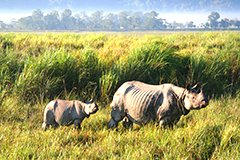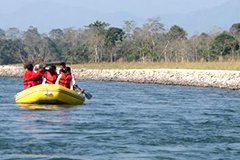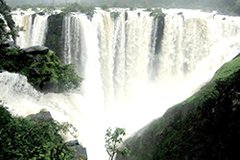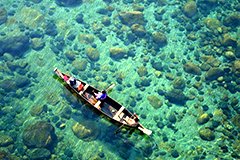Sublime North East
10 Nights/11 Days
Kaziranga-2, Nameri-2,Shillong-3, Cherrapunjee-2, Guwahati-1
Sublime North East
10 Nights/11 Days
Kaziranga-2, Nameri-2,Shillong-3, Cherrapunjee-2, Guwahati-1
Day 1
Guwahati>>Kaziranga (250 kms/ 5 hrs drive)

Pickup from Guwahati airport/railway station & transfer to Kaziranga National park – a world heritage site, the park hosts two-thirds of the world’s Great One-horned rhinoceros. Kaziranga also boasts the highest density of tigers among the protected areas in the world and was declared a Tiger Reserve in 2006. Though sighting of tigers are difficult because of the tall grasses that provide excellent camouflage, their presence can be felt everywhere by way of pug marks, kills and territorial markings. The park is home to large breeding populations of elephants, wild water buffalo and swamp deer. Arrive at hotel. Overnight stay at Kaziranga.
Day 2
Kaziranga National Park



Early morning at 06.30am take an Elephant ride for 1 hour. Return to lodge by 8am for breakfast.
After breakfast, take Jeep Safari to the Central Range of Kaziranga National Park. Back to the hotel by evening, overnight stay at Kaziranga.
Day 3
Kaziranga National Park>> Nameri (125 Kms/02 Hours)



After breakfast, checkout and drive to Nameri National Park. The Nameri National Park of 200 sq kms area is located in the Sonitpur district, bordering Arunachal Pradesh and it is also the core area of Nameri Tiger Reserve (344sq kms). It is the home of Mammals like Elephant, Tiger, leopard, Sambar,Barking deer, Hog Deer, Wild Boar,Gaur, slow loris,gaplangur, Burmese ferret badger, and over 350 species of birds including White-winged Wood Duck, Ibisbill (uncommon), Ruddy Kingfisher, Palla’sfishing eagle,Lesser Adjutant stork , Greater spotted eagle,Rufous necked hornbill, Great pied Indian hornbill, Wreathed hornbill, Long-billed Ringed Plover, Sultan Tit, and Yellow-bellied and White-throated Fantails. Another important wild life sanctuary of Arunachal Pradesh The Pakhui (Pakke) wild life Sanctuary adjoins the Park on its North-Eastern point. The river Jia- Bhoroli and its tributaries namely the Diji, Dinai, Doigurung, Nameri, Dikorai, Kharietc crisscross the park. During rainy season A few jheels (during the rainy seasons) also dot the area. One can enjoy rafting in the Jia Bhoroli river in the south western boundary. Arrive and check in at Eco Camp.
Rest of the time free at leisure. Overnight stay at Nameri.
Day 4
Nameri National Park



Early morning go for the nature walk and the bird watching trip into the dense jungle of Nameri National Park with the forest guards.
Breakfast, lunch and dinner at the camp. Overnight stay at Nameri.
Day 5
Nameri >> Shillong (250 Kms/07 Hours)



After breakfast depart for Shillong, the Scotland of East.
En route visit
Barapani (Umiam Lake): As per the legends, two heavenly sisters decided to make their way to Meghalaya. However, one of them had reached the destination and the other could not due to some reason. So the former could not trace out her sister and started crying with her broken heart. She cried so much that and a lake was formed with her tears. Locally known as Umiam Lake, Barapani means vast waters.
Today it becomes a hub for the water sports activities such as speed boats, sailboats and water scooters. Adjoining to the lake, the Nehru Park offers an aviary and a collection of orchids and butterflies. ………Arrive Shillong and check in at hotel.
Shillong: The Capital of Meghalaya, Shillong is one of the major tourist destinations in North East India. The British loved this place so much that they had established its Capital for Eastern Bengal and Assam For its climate and unique topographical features the British referred Shillong as the “Scotland Of The East”. Overnight stay at Shillong.
Day 6
Shillong



Local sightseeing in and around Shillong – Don Bosco Church, Wards Lake, DBCIC, Police Bazaar for shopping. Overnight in Shillong.
Day 7
Shillong>> Mawsynram >>Shillong



After breakfast drive to Mawsynram which is a village in the East Khasi Hills district of Meghalaya state in north-eastern India, 65 kilometres from Shillong. It is reportedly the wettest place on Earth, with an average annual rainfall of 11,872 millimetres (467.4 in). Visit the Shivling inside the cave & Onwards to Shillong & overnight stay at Shillong.
Day 8
Shillong >> Dawki >> Mawlynnong >> Cherrapunjee



After breakfast drive to Dawki, The small border town of Dawki in the West Jaintia Hills has the famous river Umngot which is a major tourist destination in Meghalaya. Dawki lies between India and Bangladesh and is the trade hub between the two countries. This small city is also famous for its famous Umngot river and a beautiful bridge.
People flock to the city to enjoy a boat ride in the Umngot river, and view of the nearby sights. During the spring season the tourist activities can be widely seen. A boat riding competition is hosted. The cold water, beautiful suspension brides and the surrounding greenery make it a worth visit.
BOATING CHARGES ON DIRECT PAYMENT AT DAWKI RIVER
Onwards to Mawlennlyong- said to be the cleanest village in Asia. Visit the sky view point- a maze of bamboo pathways which takes you above the tree tops to get a clear view of the Bangladesh plains. Mawlynnong is a village in the East Khasi Hills district of the Meghalaya state, India. It is famous for its cleanliness and natural attraction. Mawlynnong was awarded the prestigious tag of ‘Cleanest Village in Asia’ in 2003 by Discover India Magazine.
Onwards to Cherrapunjee, which experience the 2nd heaviest rainfall in the world. Cherapunjee is also famous for the beautiful landscape.
Cherrapunji, currently the historical name Sohra is more commonly used; alternative spellings are Cherrapunjee and Charrapunji), is a subdivisional town in the East Khasi Hills district in the Indian state of Meghalaya. It is credited as being the wettest place on Earth & overnight stay at Cherrapunjee.
Day 9
Cherrapunjee



After breakfast, proceed to Cherrapunjee sightseeing, scenic circular route covering:
1. Mawsmai caves, situated around 6 Kms from Cherrapunjee, these limestone caves have the distinction of being the only caves in Meghalaya that are lit enough to enable people to enjoy the natural formations inside. Though the caves are long, only a distance of 150 meters is open for tourists, while the rest is closed. The stalactites and stalagmites in the caves come in innumerable forms, shapes and sizes. This magnificent natural wonder has been created by years of natural abrasion and flowing underground water. 2.
Seven Sisters Fall, plunging down a height of 1,035 ft, the Nohsngithiang Fall is the fourth highest waterfall in India. This fall is located a few kilometres from Cherrapunjee. The fall derives its name from the seven streams that flow down the plateau. This waterfall is also known as Seven Sister Fall or Mawsmai Fall, the latter being the name of the village – a must see during the monsoons, when the streams are inundated with water and flow down rapidly forming a perennial rainbow.
3. Nohkalikai Fall
4. Dainthlen Fall
5. The Living Root bridges (Umkar Root Bridge) are made from the roots of the Ficus elastica tree, which produces a series of secondary roots that are perched atop huge boulders along the streams or the riverbanks to form bridges. The living root bridges, some of which are over a hundred feet long, take ten to fifteen years to become fully functional, but they’re extraordinarily strong – strong enough that some of them can support the weight of fifty or more people at a time. The bridges are alive and still growing and gain strength over time.
Back to the hotel by evening. Overnight stay at Cherrapunjee.
Day 10
Cherrapunjee>> Guwahati (4.5 hrs, 160kms)



After breakfast, transfer to Guwahati. check-in at the hotel & proceed to Kamakhya Temple, Balaji Mandir, Fancy Bazaar…. Evening visit Kalakshetra & do the boat ride on the Brahmaputra river (OPTIONAL ON DIRECT PAYMENT). Overnight stay at Guwahati.
Day 11
Guwahati >> Guwahati apt/Rly Stn.



After breakfast, transfer to Guwahati airport/railway station for onward destination.
** * Tour End ***

